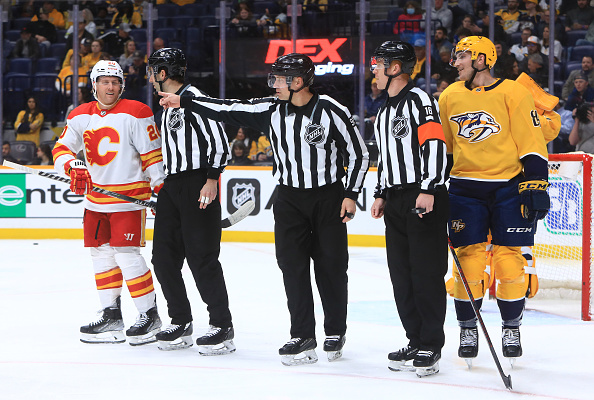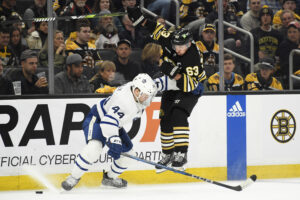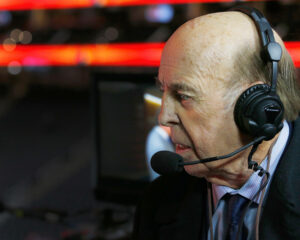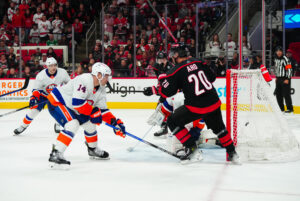Jack Han understands that hockey is a game of chaos. Players are dropped into the middle of it to get through as best they can. Ideally, they maximize it on the attack and reduce it on defence. The job of coaches is to teach them how to do this.
Chaos in Hockey with Jack Han
Hockey Tactics 2021
We’re going to start with the book that anyone interested in the sport should start with, and that’s Hockey Tactics 2021. Unlike the 2022 follow-up, it’s a very philosophical work. We certainly didn’t expect to encounter the “Heap Paradox” in a chapter on referees, for instance. But it belongs.
Inside are eleven wide-ranging chapters. A LOT of ground is covered here, from how to play better sled/sledge hockey – now renamed para hockey – with world champion Josh Pauls, to following the play of Marie-Philip Poulin for the PWHPA Showcase final in Calgary. Life philosophy mixes with specific situational advice in a fascinating way throughout.
There is an odd storytelling paradox, the more personal a story is, the more easily people can relate to it. That holds true here, as we think of our family or friends – or enemies, intentional or otherwise – who have influenced us. Names and locations are flexible so long as the story is real. You didn’t have Han’s parents, but there’s someone in your life who made you feel the way he did at that moment. It simply works.
Hockey Tactics 2021 isn’t just stories, of course. It is a very practical book as well, going into detail on specific plays. It’s fun following Joe Pavelski as he arrives “fashionably late” to the play, a polite term those of us of a certain age and skill level appreciate. But there’s a lot of detail about how he uses his linemates to keep himself as effective as possible.
Hockey Tactics 2022 and Olympics WHKY – The Playbook
The release in 2022 is a very different beast, or beasts as it happens. Hockey Tactics 2022 and the additional Women’s Olympic Hockey manual are both subtitled “The Playbook”. Inside is every NHL team with an illustration of seven different plays, all at five-on-five. The women’s hockey teams get the same treatment, though Han only uses the three predominant international teams.
Han uses a series of seven situations, from offensive zone possession to defensive breakouts, to show how differently each team handles them. In some cases, there’s a special player who is the reason for a play existing. Pittsburgh’s chapter, for instance, has two plays with names attached and they’re exactly who you think. With clear, bare-bones illustrations and just a quick summary, you’ll start to see patterns emerge. It’s a great way for any coaches to use what the pros use and bring new plans to their team. We also like these manuals for fans who want a new way to think about their favourite sport.
Don’t go thinking the book is without personality, though! It’s just of the “More knowledgeable friend describing the moves on the screen” variety than HT2021 is. Han’s love for the game doesn’t stop him from wanting it to improve, after all. And he’s obviously not one to hoard information. Next time you watch your favourite team, have their chapter open. You might not catch every play every time, but once you start recognizing them it becomes another layer to enjoy the game.
Hockey Tactics Retrospective Part I: 1975-1986
This one is the most fun for the hockey nerds among us. And admit it, if you’re reading this, you just might qualify. Whether you are too young to have seen them or too old to remember them as well as you think you do, this book is loaded with excellent detail about some of the biggest games in hockey history.
Most, of course, involve the NHL or North American teams. That’s who prospective readers likely know best. But which games are included makes a fantastic selection. The CSKA vs. Montreal Canadiens match from 1975. USA’s Miracle on Ice against the USSR. Game Three of the 1982 Stanley Cup Final between the powerhouse New York Islanders and the wildly improbable Vancouver Canucks.
This volume really clarifies how structures create plays, even if not in the most predictable way. The real-world example of a small slip-up on defence and how quickly it can be taken advantage of gives a reader a whole new level of respect for the people who play this gloriously ridiculous sport for a living. Finding the games again is an irresistible impulse after reading any of these chapters.
With Jack Han
We wrote author Jack Han to ask a few questions that the books inspired, and he was generous enough to reply.
LWOS: Coaching has come a long way from the days of “Captain Video” himself, Roger Neilson. Now teams have coaches for each position, for special teams, and for video of course. How do those coaching styles integrate? Do the plans come from the head coach exclusively and go to the assistants, or do the assistants advise the head coach on what they think the players can do?
Jack Han: The most important shift, I think, is that an NHL coaching staff is far bigger than it was a generation or two ago. In the 1970s some NHL benches only had two coaches on them. Now we’re up to four, with another one or two up in the press box. The ability to delegate is now super-important. If you’re a smart coach, then you’ll realize that your assistants are either fresher or smarter than you in tackling some of the problems your team is faced with, and you’ll let them do their jobs.
LWOS: You talk about how different rinks used to be in each arena. When it comes to size, how much of a difference is there between 185 feet from 200 feet? Can you prepare players for that?
Jack Han: When you spend so many years playing a sport at a high level, even small differences in ice dimensions make a big difference mentally. On the offensive side, there is more space on 200ft-wide ice but you want to be cognizant of not taking too many poor shots from outside the dot lanes. On defence, you want to “hold” those dot lanes and avoid chasing so far outside that you can’t get back into the middle in case of a lateral pass.
LWOS: Some plays in Tactics 2022 mention certain players. How often is a generic plan turned into “Get Sidney Crosby the Puck”?
Jack Han: It’s a question of frequency. Lots of players can do the lacrosse move. Now it “belongs” to Zegras because he’s the only one to do it on a regular basis.
LWOS: And because Last Word on Gaming needs to know: have you ever played a hockey management game? Out of curiosity if nothing else?
Jack Han: I played an extremely old hockey management game when I was younger. Didn’t find it interesting – reality is a game of its own, with unpredictable mechanics.
Find Them and Use Them. Or Just Read Them. Either’s Good!
Jack Han’s books are all available at his Gumroad site here. Unreviewed here, we’re going to be getting his Hockey Tactics 2020 soon. “Out of date” doesn’t mean much when the stories are this entertaining. He continues to inform hockey fans from his Hockey Tactics Newsletter Substack.
Don’t kid yourself about his boredom with computer games, though: he also wrote Chel Guide. For those out of the gaming loop, it’s all about how to win at EA SPORTS NHL21. He may have found computer management dull but on the digital ice? There are lessons to be learned.
Main Photo:






